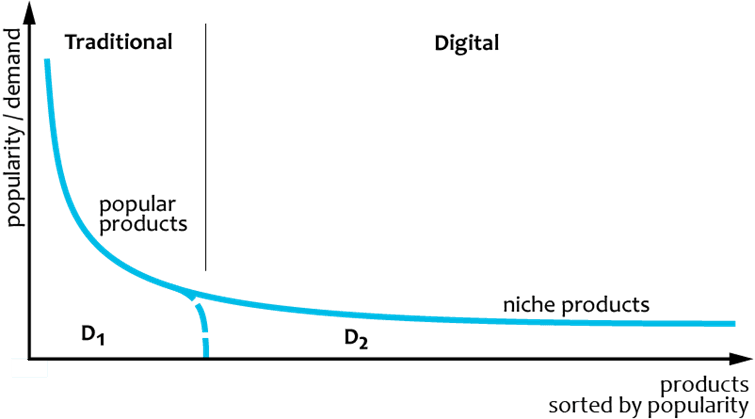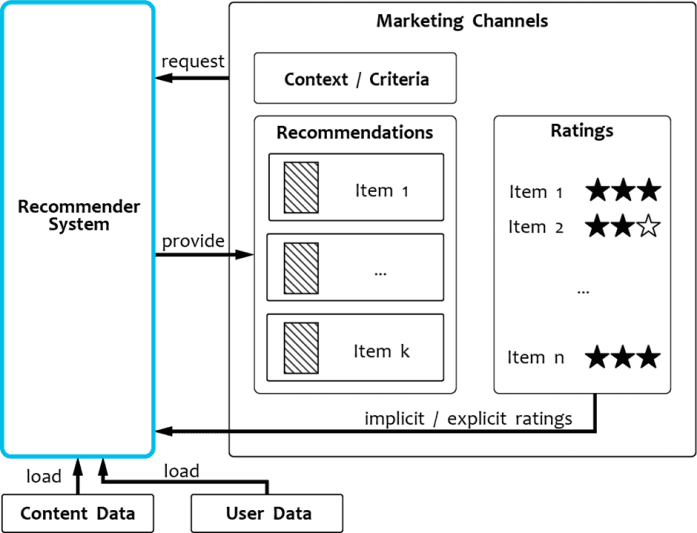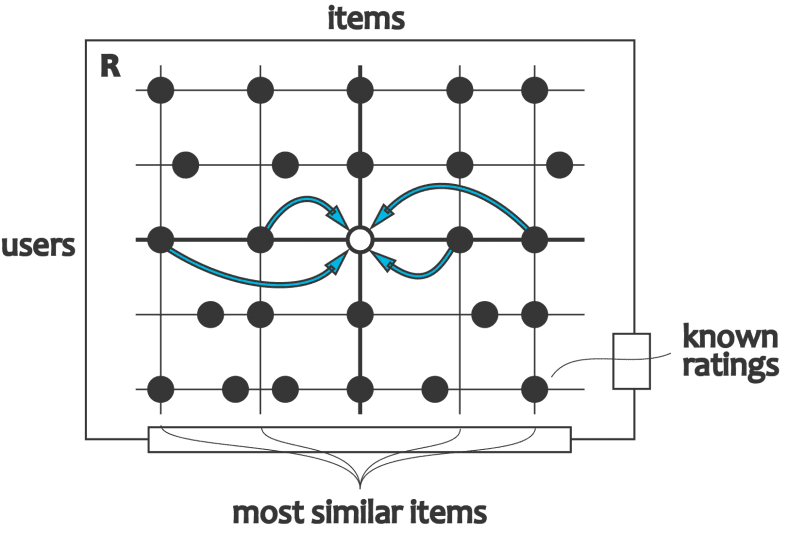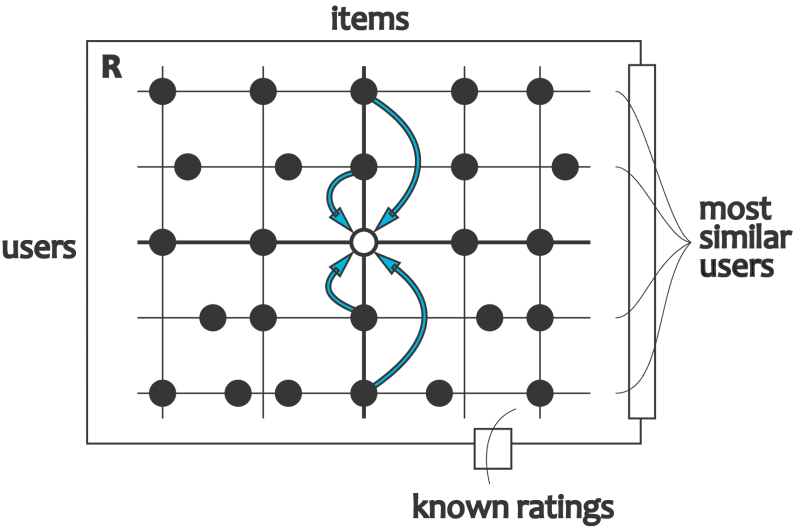How to boost your sales with a recommender system
One powerful way to boost your sales, customer satisfaction and customer loyalty is to use a recommender system. Such a system enables you to draw up user profiles based on their behaviour and to predict which products are most relevant to such profiles. A user profile specifies the properties of how much interest a customer has in a particular product.
Help costumers identify their needs faster
Let’s start with a fact, the variety of products and services you can offer in a physical store is limited by several factors including distribution and production costs. For example, a grocery store can carry only a certain number of products that are limited by the available shelf space. You can increase capacity and expand the assortment, but the additional revenues captured by this expansion start to diminish after a certain point because of the limited total demand.
Consequently, a physical seller usually has to focus on relatively popular products and offer only a limited variety of niche items. The demand for niche products, however, does exist.
This is probably one of the reasons why you have invested in an online store.
These digital channels do not have limitations such as physical stores. An online store enables you to carry extremely wide and deep assortments with a large number of slow-moving niche products.
More relevance equals more conversion
While the physical store is limited to the people who live in or visit that area, and so the variety of demand is similarly limited. An online retailer that operates nationwide or worldwide faces much more diverse demand. The impressive increase in the assortment with a strong emphasis on niche products challenges the old approaches to product discovery because an average customer can browse only a tiny fraction of available offerings.
Various websites report that a user spends less than 10 minutes on an e-commerce website. This means that when a user views each product for 10 seconds, he/she has viewed 60 products by the time of leaving the website. This is very often a fraction of the range of products on the website. There is a small chance that the customer will come across the product he/she was looking for. And that is only in case the customer knows what he/she is looking for.
This need for powerful product discovery services was one of the main drivers behind the development of recommender systems. Customers don’t buy what they can’t find. But what if AI did the heavy lifting, automatically tailoring product discovery as shoppers explored your digital catalogue?

Extremely wide and deep assortments with a long tail of niche products create a need for efficient discovery services, such as recommendations.
Recommender systems are not new. In 2006, Netflix started a one million dollar competition to improve their recommendation algorithms. In 2019, 75% of their viewed content is attributed to personalized recommendations.
In contrast to a search bar in your digital store, that has a query to work with and can score products according to it, a recommender system needs to guess the purchasing intent based on indirect information. This is crucial if you want to activate visitors who are just browsing your site without a specific item in mind. And this is the key to maximize the conversion rate on your online store.
Main objectives of a recommender system
- Relevance: The recommendations suggested to a visitor are relevant, in the sense that a user has a high tendency to purchase the recommended items and rate them highly.
- Newness: A recommender system does not fulfil an explicit search request but rather advises visitors on available options. Our systems can recommend popular items to the visitor that he/she is likely to be aware of.
- Serendipity: Recommendations can help a user to discover products that are unexpected and surprising, as well as unfamiliar. On the other hand, a recommender system can be serendipitous. For example, a user who buys Star Wars figures can be recommended to visit an amusement park with a corresponding attraction or users who are interested in books about the first world war can be recommended to buy related musical tickets.
The main goal of recommendation systems is to provide customers with relevant offerings when the purchasing intent is not explicitly expressed.
How it works
The basic settings for recommendation services are similar to those for search services. Similarly to search services, the primary purpose of a recommender system is to provide a customer with a ranked list of recommended items.
- The vast majority of recommendation methods make the assumption that customer ratings are available for catalogue items. The ratings can be explicitly provided by customers or derived from behavioural data, such as purchases and online browsing histories.
- Certain recommendation methods rely on content and catalogue data to calculate similarities between the items based on their attributes.
- Some recommender systems can take advantage of additional user data, such as online order histories or store transactions.
- Both recommendation requests and customer ratings can be complemented with contextual information, such as time, location, or marketing channel. A recommender system can use contextual data to improve the relevance of recommendations.

Overview of recommendation methods
Our machine learning solutions offer a wide range of algorithms for building recommender systems. The recommendations are calculated based on information extracted from :
- user interaction (and transaction) data collected via the website
- available product item data
Collaborative filtering
There are many techniques to set up a recommender system but this technique is still one of the simplest methods and takes into account all interactions of all users. Collaborative filtering calculates relationships between users or product items and makes recommendations with a high level of trust. The two most frequently applied methods are:
Item or content-based collaborative filtering
With a content-based system, a movie streaming service might notice that you liked “Terminator 2” directed by James Cameron and that he also directed “Titanic” and will suggest that, or that you rented a film with Arnold Schwarzenegger and will recommend another film with him.
We start off building a matrix for the client and the items they have purchased or liked, and then use a profile of the items’ attributes. These attributes may be binary, such as whether the movie is or is not an action film, or scalar, such as whether it has 1 to 5 stars.
There are many solutions that our experts can use to interpret this data, such as Bayesian classifiers, clustering, decision trees, neural networks, and text analytics (when recommending news articles).
In the figure below you can see an illustration of the approach of item-based filtering. In order to predict ratings for a given item, we first find items that are similar to the given one, in the sense that they are similarly rated by the same users. Next, the rating that a given user will give to this item is estimated based on the ratings that the user gave to other items in the neighbourhood. Once again, the key assumption is that a user who positively rated a few items in the past will probably like items that are rated similarly to these past choices by many other users.

User-based collaborative filtering
Another way of predicting user preference would be collaborative filtering, creating a vector of items bought by other users that have been rated negatively or positively and if one user’s vector is similar to others, the model recommends the items others have rated highly but the user has not bought. So in a nutshell, the idea behind user-based collaborative filtering is to find users with the same taste as a certain target user. Recommendations can be direct, such as a Coolblue review, or inferred, such as liking a news article or viewing this type of article often.
The idea behind user-based collaborative filtering is to find users with the same taste as a certain target user. For example, if Julie and Sophie bought the same dresses in the past, we consider these two to be similar users and we can use the shopping history of Julie to predict Sophie’s yet unknown shopping behaviour. For example, if Julie bought a red dress and a blue dress, and Sophie also bought a red dress, then the blue dress will be a logical recommendation for Sophie.
The advantage of this approach is you need very little understanding of the item being recommended. You might even introduce the user to something new.
The disadvantages are that you need a lot of data to make this accurate.

We can also use the methods as a mixture to achieve the goal. For example, we built a recommender system for an online newspaper where the systems filter the available items (articles) based on a description of these items (some keywords) and the user preferences being the reading history. These algorithms try to present articles similar to those that have been reviewed (read) in the past.
Our proven technology
To better inform your customers about your product offering, adverts and offers are very important. Through printed media, online ads and newsletters you can inform the customer, but which products deserve extra attention? The optimal selection of products maximizes the amount of sales but a personalized selection is needed since every customer is unique.
Through advanced machine learning techniques, ML2Grow can make this selection for you. Based on the historical sales data of all customers, our recommendation engine calculates the most effective selection of products to suggest for each customer. This selection can then be integrated into existing business processes.
Many of the recommender algorithms that are being offered in big software packages are implementing basic technology. At ML2Grow we make use of the latest proven advances in machine learning such as deep auto-encoders which offer much better performance and accuracy. Also, we customize the solution completely to match your company’s market positions, offering you an even higher return on your investment.
Various studies show that recommender systems result in a turnover increase of between 3 and 6%, and also have a positive effect on the diversity of purchases. It is therefore not surprising that more companies are taking the step to adopt this technology. If competitors invest in this, there is a risk that your turnover will drop significantly.
With our expertise, we are able to develop recommender systems for every operation and context. Our innovations speak for themselves, from our smart content recommender technology NewsTAPAS to helping PROTEGO incept context-aware and explainable recommenders to enrich calls between caregivers so that senior people can live longer and more comfortable at home. Our recommender technology platform expanded from media consumption and smart home applications to healthcare applications. ML2Grow is a pioneer in developing recommender technology.
- Our solutions are tailor-made to fit your needs
- We go the extra mile for our clients
- We are technology independent
- We are pioneers with PhDs and push ourselves every day to stay the best in the business
If you are interested, we are happy to provide you with more information. Please contact our sales and let’s discuss your problem.